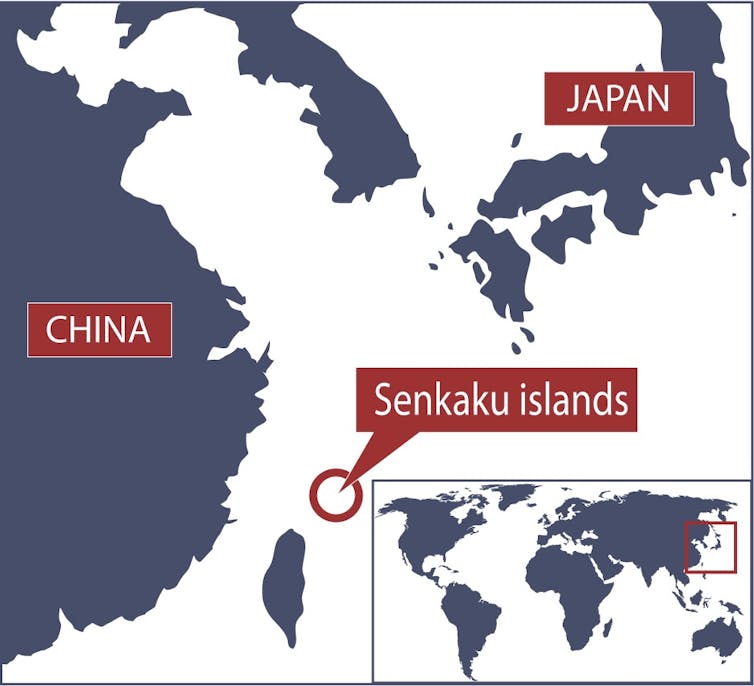Source: The Conversation – UK – By Lewis Eves, Lecturer in the School of Politics and International Relations, University of Nottingham
Tensions are rising between China and Japan again over a dispute in the East China Sea. Such tensions are usually over the Senkaku Islands, an uninhabited chain administered by Japan but claimed by China. The current row, however, stems from international anxiety over a possible Chinese invasion of democratically ruled Taiwan.
On November 17, in her first parliamentary address since taking office in October, Japan’s prime minister Sanae Takaichi suggested that her country could intervene militarily in the event of an attack on Taiwan. Takaichi’s comments sparked anger in China, with state media framing her rhetoric as reminiscent of Japanese acts of violence towards China during the second world war.
Beijing has demanded that Takaichi retract her comments – a call she has rebuffed – and is advising Chinese citizens against travelling to Japan, claiming there has been a deterioration in public security there. China has also introduced a blanket ban on Japanese seafood imports as the row continues to escalate.
The ruling communist party, which frames itself as the protector of the Chinese nation, has long sought to reunify China following the so-called “century of humiliation”. Starting with the first opium war in 1839 and concluding with the end of the second world war in 1945, this period saw China victimised and partitioned by various foreign powers.
Taiwan is thus problematic for the party. The island state broke away from China in 1949 at the end of the Chinese civil war, and its autonomy from Beijing contradicts the goal of national unity that the party has promised. Some observers fear that China will seek reunification through force, with some predictions suggesting it will be ready to invade Taiwan as soon as 2027.
There is no guarantee that an invasion will occur. But the international community, led by the US, is preparing for a confrontation over Taiwan regardless. On the same day Takaichi made her comments, the US government announced it had agreed to sell US$700 million (£535 million) of arms to Taiwan.
In this context, Japan’s show of support for a strategic partner in the region is not surprising – yet Takaichi’s remarks about Japanese intervention are particularly provocative for China. One reason is that Japan occupied and colonised Taiwan from 1895 to 1945, contributing to China’s century of humiliation. This makes Japanese threats to intervene in Taiwan’s defence a contentious prospect for China to consider.
Another reason is that anti-Japanese sentiment is a prominent characteristic of Chinese nationalism. Many Chinese nationalists are vocal in condemning Japan for any provocation, pointing to historical atrocities committed against China as evidence of a need to stay vigilant against renewed Japanese aggression. The idea of Japan intervening to maintain the status quo in what China considers a breakaway province probably falls under their idea of an aggressive act.
Will tensions escalate?
Outright conflict between China and Japan remains unlikely. It is possible that Takaichi’s remarks were simply an effort to shore up domestic political support, rather than a genuine military threat.
Her rightwing Liberal Democratic party (LDP) previously governed Japan in coalition with the centre-right Komeito party. This coalition broke down in October 2025, forcing the LDP to rely increasingly on its nationalist base for support – a group that is generally suspicious of China’s growing military and economic strength.
Irrespective of Takaichi’s motive, China has responded assertively. It sent its coast guard to the Senkaku Islands in what it called a “rights enforcement patrol”. The Japanese government has also accused China of flying military drones near Japan’s most westerly territory, Yonaguni, which is close to Taiwan’s east coast. Any misfire risks open hostility between the two nations.

vadimmmus / Shutterstock
Relations between Japan and China are tense, yet I see cause for optimism. Takaichi has positioned herself as a successor to the late Shinzo Abe, who served as Japan’s prime minister from 2006 to 2007 and again from 2012 to 2020.
Like Takaichi, Abe promoted an assertive Japanese foreign policy. He oversaw reinterpretations of Article 9, the pacifist clause of Japan’s constitution, to lessen restrictions on his country’s use of military force. This included passing legislation in 2015 which allows Japan’s self-defence force to deploy to protect the country’s allies. This legislation has enabled Takaichi to consider military intervention in Taiwan’s favour.
When Abe entered office in 2012, it was also a tense time for China and Japan. Japanese nationalist activists swam to the Senkaku Islands and raised their country’s flag, triggering massive anti-Japanese protests in China. Tensions remained high for several years, with both countries deploying ships and warplanes to the region.
This resulted in several near-misses that could have escalated into outright conflict. In 2014, Chinese fighter jets flew extremely close to a Japanese surveillance plane and intelligence aircraft near the islands, passing about 30 metres from one plane and 50 metres from another.
However, once tensions passed, Abe and China’s leader, Xi Jinping, oversaw several years of relative calm and cooperation between their two countries. In fact, this is usually linked to the familiarity Abe and Xi developed through their interactions while managing their countries’ mutual animosity over the disputed islands.
So, if Takaichi can follow her mentor’s lead and successfully navigate the tensions to build an effective working relationship with Xi, a more stable relationship between China and Japan in the future is still possible.
![]()
Lewis Eves does not work for, consult, own shares in or receive funding from any company or organisation that would benefit from this article, and has disclosed no relevant affiliations beyond their academic appointment.
– ref. Why Japan’s support for Taiwan has gone down so badly in China – https://theconversation.com/why-japans-support-for-taiwan-has-gone-down-so-badly-in-china-270112












